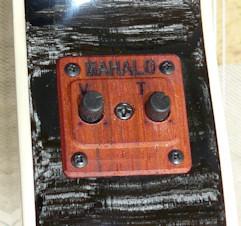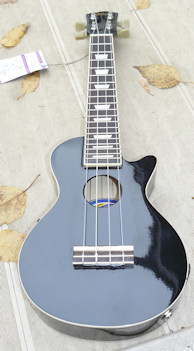



Mahalo
Most of us have seen those inexpensive ukuleles, sometimes decorated with sequins and sparkles, and painted in many "designer" colours. They hang in the uke-unaware music stores. Many of them bear the brand name "Mahalo."
In my experience they are Chinese-made, mediocre quality, with poor intonation, laminate tops, and sharp or ragged fret edges. Not to mention they're seldom in tune. That's because these stores don't treat ukuleles as "serious" instruments. These uke-unaware shops don't bother to stock anything better than the bottom-of-the-barrel instruments, so why do anything like tune them? At $30-$40, they're not on par even with the laminate models in lines like Kala, Ohana and Lanikai.
But for many players, Mahalo is the first uke they own. That's in part because of the paucity of models and brands available at local stores, but in part because a musical instrument under $50 isn't really a big investment. Just enough to get you hooked. Owning a Mahalo is almost a rite of passage in the ukiverse.
Well, Mahalo actually makes better instruments, although you sometimes have to search around to find them. They make, for example, ukes with solid spruce and cedar tops. Good luck finding one! Or trying to convince a music store to bring one in for you to test. But
What you're more likely to come across are two Mahalo electric/acoustic ukes, one shaped like a mini-Les Paul (the ULP1/VS) or one shaped like a mini-Fender Telecaster (the UTL1/VWT). The Tele-clone has a Fender-style head, as well.
Both are, as far as I know, only soprano size. I seem to recall having seen tenor versions of them in the past, but perhaps these models were discontinued.
Both have active pickups, small battery-powered pre-amps built in, plus external tone and volume controls (see photo, at left). The pickup jacks exit off-centre, towards the bottom, and are not designed as strap holders, although you could change that yourself. The battery is inserted in a small plastic case on the bottom (see small extrusion in picture, bottom left).
They provide a surprisingly clean signal and good sound when amplified. However, the small body doesn't provide a lot of depth or sustain, so you will need to use amp effects like reverb to improve the sound.
Both models are laminate, of course, with high-gloss finishes in a range of colours, including sunburst and tobacco.
Both have 18 frets (although anything above 12 has very little finger space and is mostly decorative). They are, like the originals, cutaway bodies. Saddles are Nubone, and the bridges are rosewood.
The bridges are a bit blocky, I suppose to attempt some sort of reasonable similitude, but they're a visual weak spot that could be improved, at least in design terms.
Strings are Aquila, which surprised me a little, because they aren't inexpensive strings. Action is good and the intonation is good up to the seventh or eighth fret - certainly much better than the $30 models, but not precise at the higher frets. But I personally don't play much above the seventh fret on a soprano, anyway.
Fret edges were reasonably smooth, too, although a little work with a small needle file would improve them. The ukes are not premium instruments, but are acceptably well made. There's certainly no frills on them.
The Canadian retail price is, I believe, around $140, but I've seen these ukes selling for around $100 and even less. At that price, they're a nice option for people who want to get started with ukuleles, want the electric option, but don't want to commit to a lot of money in order to discover what ukes are all about.
The best thing about these Mahalos is their shape. They're irresistibly cute. What uke player doesn't want to pick up a tiny Tele and wail away with some Hendrix or Santana riffs? I borrowed on from Blue Mountain Music for a weekend of doing just that. And I convinced the local library to add a couple of these Mahalos to their collection (members can borrow a uke, with tuner and chord book, for three weeks at a time).
I didn't buy one because all the store had to offer were sopranos.I'm really a tenor aficionado, and I'd buy a tenor model if they had one, just for the fun they offer.
Update: Mahalo has apparently improved both their input jack and pre-amp. Latest reports on the Ukulele Underground say it now comes with a more powerful 9 volt battery, instead of a smaller 3 volt. That should give it some added zip.
Would I purchase another Mahalo? Possibly a tenor
electric, but not a soprano.
Would I recommend them to others? Yes, with caveats and qualifications.
Good starter ukes.
Rating (0-5): **1/2
Status: Borrowed from Blue Mountain Music,
returned.
